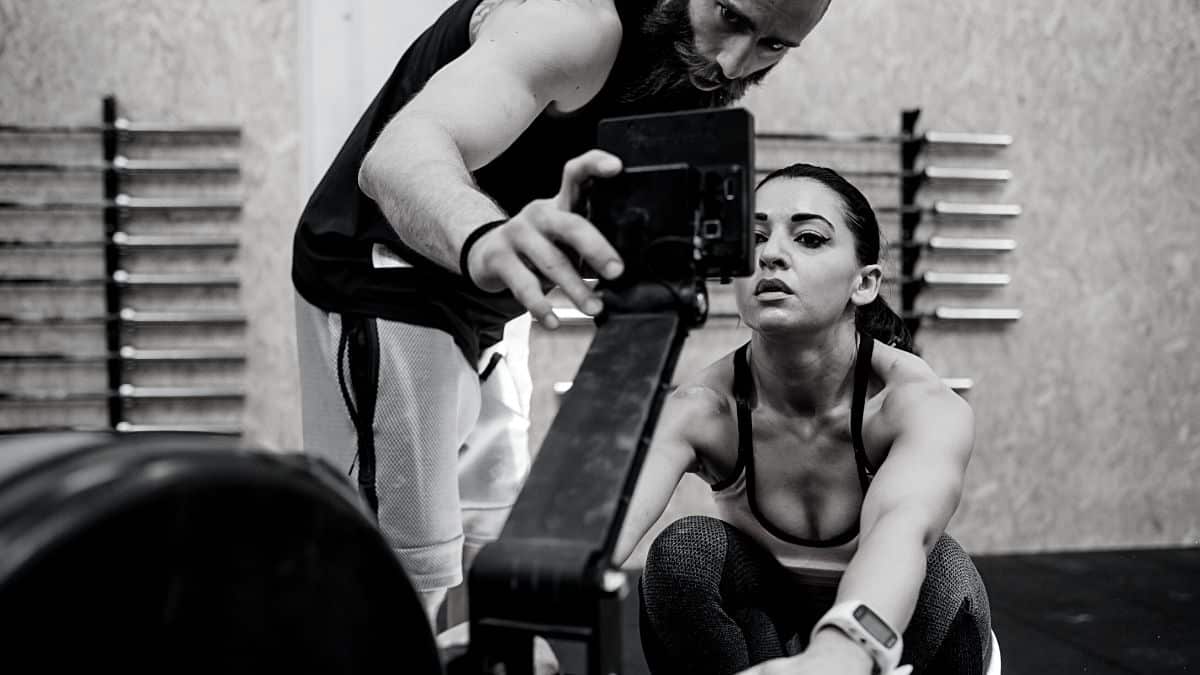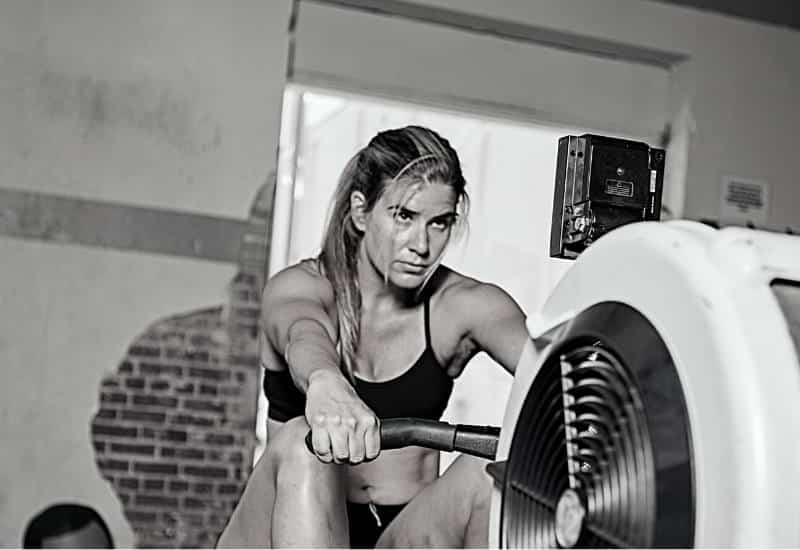Stroke rate is an excellent metric for more efficient workouts on the rowing machine. Here’s your guide to rowing machine stroke rate, why it’s important, and how to improve it.

If you’re going to spend time training, why not train right?
That means more than just putting in the time and the bare minimum amount of effort.
Smart, effective training means making the maximum use of everything at your disposal—all the tools, tech, and techniques made available by modern exercise machines.
When it comes to the rowing machine, stroke rate is one of the best tools you can use to track, monitor, and evaluate your rowing performance.
Knowing how to use the stroke rate correctly is the key to making the most of every training session, and really pushing your body as hard as possible.
In this article, we’re going to take a deep dive into rowing machine stroke rate, looking at what it is, what benefits it offers, what is an “adequate” or “excellent” stroke rate, and how to how to use the rowing machine right to improve your performance based on that stroke rate.
Let’s jump right in.
What is Stroke Rate?
The term “stroke rate” refers to the number of strokes you perform in a single minute.
Also called “Strokes Per Minute” or “SPM”, it’s a metric that lets you know just how fast you’re rowing, which essentially translates into just how hard you’re working.
Every single type of rowing machine that comes equipped with a digital monitor or stroke counter of some sort will display the stroke rate.
It’s one of the simplest, easiest ways for you to track your performance throughout the entire rowing workout.
Benefits of Using Stroke Rate for Your Rowing Machine Workouts
There are quite a few benefits of rowing machines stroke rate that you need to know about.
The main benefit, and the reason that stroke rate is monitored in the first place, is in order to make sure you, the trainee, know just how hard you’re working.
The difficulty of the rowing session is determined by a number of factors:
- The resistance of the machine. The higher the resistance, the more effort will be required to haul on the rowing machine handle. Greater resistance will mean more calories burned over the course of your workout.
- The speed of your stroke. This is measured by your stroke rate. Typically, the faster you row (the more strokes per minute), the more you are moving your body through the various stages of the rowing stroke. That movement means more calories burned through your workout.
- How hard you haul on the handle. This is actually a more accurate and effective measurement for workout intensity than simple stroke speed. A faster cadence won’t necessarily cover greater distance, but pulling harder (and with greater efficiency) on the handle will. Remember, that pulling motion is where all of your effort is invested, and the sliding forward is just your body returning to its starting position.
The reason that you track strokes per minute is that it sets a speed or cadence to follow. Typically, you use it to get your body up to the correct speed in order to get an efficient workout (based on your target heart rate, intensity, distance, etc.).
Once you’ve got that correct SPM, that’s when you really settle into the correct movements, hauling on the handle with maximum power and letting your body naturally recover and return to starting position on its own.

Stroke rate is what gets you started moving; using the correct form is what will really make your workout happen!
Using stroke rate also helps you to be aware of how hard you’re working, so you can make adjustments as needed.
For example, maybe you’re working at a specific stroke rate and using proper technique, but you’re finding that it’s just too easy, or maybe you’re not covering as much distance as you had intended for your workout. You can increase the stroke rate to push harder or travel farther within the allotted time.
Or, maybe you find that the workout is too hard, that you’re tiring or winded, or your form is suffering because you’re pushing your body too much. You can slow down your stroke rate to give your body a break and return it to its “target” function.
Whether you’re doing a rower machine workout for beginners, a more advanced ladder workout, or a row machine HIIT workout, stroke rate will come in handy to help you stay aware of just how hard you’re working.
What is a Good Rowing Stroke Rate?
What makes a stroke rate “good” is a bit subjective, but here are some general ranges to give you an idea of what kind of workout you will get when using stroke rate:
18-22 SPM
At 18 to 22 SPM, you’re working low and slow. Your heart won’t really pump too hard, but it’s the perfect warm-up pace to get your muscles limber, your joints flexible, and your blood pumping. It’s also a great pace to cool down at the end of an intense training session.
This slower stroke rate is also a great rate to practice your proper form and technique. If you’re new to using the rowing machine for weight loss and haven’t yet mastered the correct movements, it’s worth starting out at this slower pace to make sure that you’re moving through each of the four phases of rowing stroke correctly.
Once you’ve mastered it, you can speed up and work a bit harder.
23-28 SPM
At this range, you’ll start to feel your body working. Your heart rate will speed up, your blood will pump, and you’ll begin to feel the burn in your muscles.
For those who are totally brand new to using the rowing cardio machine for weight loss, this may be as high as you go. This stroke rate is great for “newbies” who are just trying out the workout for the first time, and who aren’t yet fit enough to push their bodies really hard.
Don’t worry if this is where you spend most of your workouts at first—you’ll get fitter with time and practice for sure.
For more experienced trainees, this is the stroke rate range for a low-intensity, steady state workout. You may find that at the higher end of this range, you’ll begin to feel your body working harder, so it’s a good target to shoot for to improve your fitness.
29-36 SPM
At this higher range, you’re getting into the higher-intensity range. You may not be able to sustain this faster stroke rate for more than 1-2 minutes at a time, and this will definitely be the “high intensity interval” or “rowing sprint” speed.
Some more advanced athletes can sustain this pace for races of up to 2,000 meters, but for the average trainee, you will spend no more than 90 seconds working at this very high pace before dropping back to a lower rate.
37+ SPM
This is really only something that professional athletes can manage. Fast rowing crews are capable of hitting speeds of up to 47 SPM, which is an insane rowing speed. For the average trainee, it’s not possible, and definitely isn’t either safe or recommended.
Typically, you’ll spend most of your time in the 22-30 SPM range. Most workouts will include a slower-paced warm-up, then increase your rowing speed in order to get your body working harder.
But don’t worry if you can’t yet hit really high speeds (28+ SPM). That all comes with time and practice; as your fitness and form improve, you’ll get closer to reaching the higher stroke speeds.

How to Improve Rowing Machine Stroke Rate
If you’re ready to take your rowing workouts to the next level and hit some faster stroke speeds, here are some tips that can help you push yourself harder and improve your rowing machine stroke rate:
? Focus on mastering your form.
When you get that form right, you’ll be able to hit much faster rowing speeds more efficiently, with less chance of getting winded or running out of steam early in the workout.
Plus, you’ll move more smoothly and run less risk of injuring yourself by trying to row too early too soon.
For a proper rowing stroke, focus on really driving through those legs as you push back. Most of the power in the “drive” phase of the stroke should come from your legs, with your core and upper body only doing about 20% of the work each.
? Slow down on the recovery.
This may actually sound a bit counterintuitive, but it’s a great way to focus on making your movements more efficient.
You’ll still push hard and move fast through the drive, really giving it all the power you’ve got, but then take a little longer on the recovery phase. For example, a 1-second drive and 2-second recovery.
What this does is trains your body to be more efficient through the entire rowing stroke, improving your form and strengthening your body in the full range of motion.
Over time, you’ll find it’s actually a whole lot easier to speed up because you’ve improved your form and trained your body to go through the movements more efficiently.
? Try sprint training.
Sometimes, the best way to speed up is just to speed up. You may not be able to sustain a higher stroke rate (30+ SPM) for long while you’re still a newbie rower, but you can sustain that fast pace for at least 30 seconds before slowing back down to recover.
And that’s exactly what sprint training is!
Set yourself a sprint—be it a certain time or shorter distance—and push yourself to row as hard as you can for that time. Then slow down and give your body a chance to recover. Once you’re recovered, sprint all over again.
With time and repeated sprint training, you’ll see noticeable improvement in your stroke rate. You’ll not only be able to hit higher max speeds, but your base speed will improve, too.
? Ladder training.
Ladder training is a fascinating approach to working out, based around SPM.
An example of a ladder workout is:
- Row at 22 SPM for 1 minute
- Row at 23 SPM for 1 minute
- Row at 24 SPM for 1 minute
- Row at 25 SPM for 1 minute
- Row at 26 SPM for 1 minute
- Row at 27 SPM for 1 minute
- Row at 28 SPM for 1 minute
- Row at 29 SPM for 1 minute
- Row at 30 SPM for 1 minute
- Row at 29 SPM for 1 minute
- Row at 28 SPM for 1 minute
- Row at 27 SPM for 1 minute
- Row at 26 SPM for 1 minute
- Row at 25 SPM for 1 minute
- Row at 24 SPM for 1 minute
- Row at 23 SPM for 1 minute
- Row at 22 SPM for 1 minute
Though you start off at a slow speed, over the course of the workout, you row faster and faster until you’re hitting very high stroke rates.
What’s great about ladder workouts is that the workout starts off slow and easy, at a stroke rate your body can handle with no problem.
At the end of every minute, you increase your stroke rate by 1 SPM, which is a minor increment that won’t be too difficult. Do this minute after minute, and by the time you’re halfway through the workout, you’re rowing at a much higher speed than when you started (or when you end.
It’ll get your body moving better and working its way up to faster speeds without jumping straight into a sprint. It’s a much more gradual way of hitting higher stroke rates, but it will feel more natural.
The Bottom Line
Stroke rate is far from the only metric to take into account when working out on the rowing machine. As you saw above, the power of your drive and the resistance you add to the flywheel will make the workout harder and challenge your body.
However, using rowing stroke will help you stay aware of your speed and make sure you’re working hard enough to reach your intended goal—be it calories burned, target heart rate, or distance traveled.
At the end of the day, anything that makes it easier to get in a better-quality workout is well worth using. A smart trainee will make the most of all the metrics at their disposal, and see better fitness and weight loss results for it!
More Rowing Machine Guides and Articles
Rowing Machine for Abs: How to Use the Rower for a Rock-Solid Core. Wondering if the rowing machine is a good way to target your abs? You bet it is—here are best practices for working abs on the rower and some sample workouts to get you started.
5 Rowing Machine Workouts for Beginners (Plus Tips for Rowing Like a Pro). The rowing machine is the perfect low-impact and full-body cardio machine for beginners. Here are five rowing machine workouts for beginners and tips for doing them like a pro.
How to Master Proper Form on the Rowing Machine (and Classic Mistakes to Avoid). The rowing machine is one of the best cardio machines in the gym for losing weight and getting in shape. Here’s how to master proper form and technique, plus some classic mistakes commonly made when rowing.